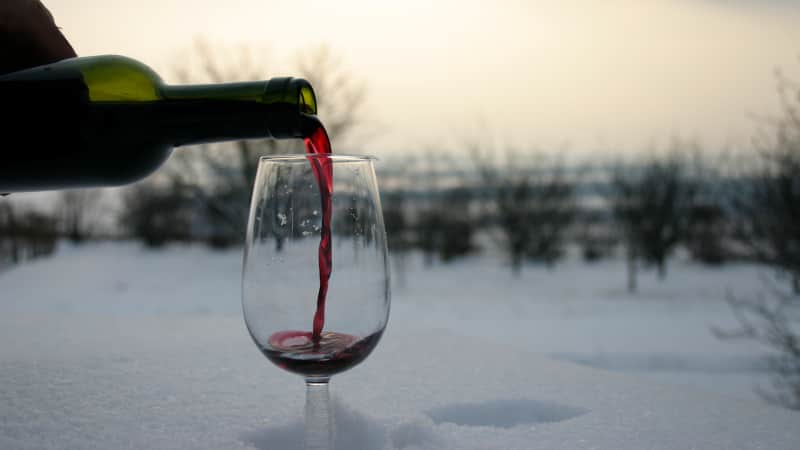While the optimal temperature for consuming wine depends on the particular variety, the consensus has seemingly always been to chill white and sparkling wines while leaving reds for room temperature. But after noticing restaurants and wine bars serving their red wines at much-colder-than-expected temperatures, I recently started wondering whether this notion has changed.
Should You Chill Red Wine?
Published Sept. 7, 2022.

Intrigued about the science behind chilled reds, I reached out to a wine bar, a local wine shop, and a sommelier with decades of experience in the wine industry in search of answers. The question: Should I chill my red wine?
Why Should You Serve Red Wines Cold?
As a person who drinks red wine exclusively, I find the temperature makes a big difference in mouthfeel: cooler wine is gentler on the nose, with more-subtle aromatic notes, before I even take a sip. The experts confirmed this.
It mellows the alcohol. Erik Segelbaum, advanced sommelier and founder of Somlyay, said the alcohol could desensitize your palate. To solve this problem, chilling could make the alcohol more subdued.
It amplifies the aromatics. "I only chill brighter higher acid wines, rather than full bodied, or high alcohol, high tannin wines," Segelbaum said. "And that chilled reds tend to work well with spice forward food."
TJ Douglas, founder of The Urban Grape, also mentioned the concept of bouquet, which refers to the complex aromas in the wine after it’s been bottled and aged.
“Alcohol evaporates quickly in a warm environment, which masks the bouquet in the process of evaporation," Douglas said. "Cold temperatures can help slow down evaporation and amplify the aromatics and make your wine taste more focused."
Which Red Wines Should Not Be Chilled?
“However, not every red should be chilled—the high-tannin, high-alcohol, and fuller-bodied wines are not good when chilled, because tannins become astringent and metallic,” Segelbaum said. “Grape varieties with higher acid content, such as Gamay; certain Italian grapes from Sicily; and any of the Germanic grapes are great for serving cold."
Mulled Red Wine
We wanted a mulled wine recipe that would not be too sweet and that would have a mild alcohol kick and deep (but not overwhelming) spice notes. After many batches, we think we've nailed it.How Cold Should Red Wine Be?
“It’s all about the perfect equilibrium,” said Maia Fleming, wine director of the natural wine bar Rebel Rebel. She keeps her wines in different fridges based on their temperature requirements.
Red wine is best served at least a little chilled. “55 to 60 degrees Fahrenheit is the ideal temperature for most reds, especially low-ABV and light reds that can be chilled even longer and served cooler, much cooler than a typical red," Fleming explained. “[One example is] the Beaujolais from France, which is in season right now.”
Fleming also shared her personal tips when it comes to chilling and serving red wine, based on her experience working at the wine bar. “We store our wines a little cooler than the optimal serving temperature, as the serving glass will warm up the wine a little.”
Sign up for the Notes from the Test Kitchen newsletter
Our favorite tips and recipes, enjoyed by 2 million+ subscribers!
How Do You Chill Red Wine?
Not everyone has a wine fridge, but experts caution against storing red wine in the fridge for long periods of time. Here are a few expert recommendations for a chilled red in a pinch.
Refrigerator: For Fleming, the task is straightforward: “For any reds, pop the bottle in the fridge for 10 minutes before meals,” Fleming suggested.
However, Segelbaum cautioned that your food fridge could be too cold for red wine.
“Food refrigerators are too cold. They’re set to run below 40 degrees Fahrenheit, which guarantees food safety. Once a bottle of wine gets too cold in a food fridge, the aromatics could get subdued alongside the tannin, which mutes the wine and doesn't taste properly,” he explained.
How To Cocktail
The first-ever cocktail book from America’s most-trusted test kitchen includes essential classics, twists on old favorites; and brand-new test kitchen creations.If a food fridge is your only choice, Segelbaum offered a simple solution: “Take it out 10 to 15 minutes before drinking and let the bottle warm up a bit from food fridge temperature.”
Freezer: In case you’re in need of a last-minute solution, Fleming also isn’t against using the freezer for white or sparkling wine. “Regardless of what route you’re taking, don’t forget your bottle,” Fleming said. “Set a 30-minute timer on your phone when sticking the bottle in your fridge or freezer.”
The great outdoors: For people who live in colder climates, Douglas has an easy trick: “If you live up north, put your bottle on your back porch for an hour on a cold day.”


